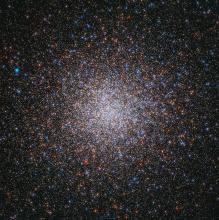Listen to today's episode of StarDate on the web the same day it airs in high-quality streaming audio without any extra ads or announcements. Choose a $8 one-month pass, or listen every day for a year for just $30.
You are here
Jhelum Stream
Most of the stars of the Milky Way were born here. But quite a few were born in other galaxies that were gobbled up by the Milky Way. Some of the remnants of those galaxies form long ribbons of stars, which makes them easier to find.
One of the most recent discoveries is known as the Jhelum Stream. It was discovered in 2018, by an observatory in Chile, and is named for a river in India. The stream runs across the constellation Grus, the crane, which is so far south that it’s not visible from most of the United States.
Jhelum is centered about 40,000 light-years from Earth. It’s in the Milky Way’s halo, which is far outside the galaxy’s disk. It’s hundreds of light-years long. And it appears to split into two ribbons. One is short and skinny, while the other is longer and wider. They move through space together, though, suggesting they have a common origin.
Astronomers are still trying to figure out just what that origin is. Most money says that both ribbons are remnants of a single small galaxy. It was a few million times the mass of the Sun. Although that sounds pretty heavy, it’s tiny compared to the mass of the Milky Way.
As the little galaxy approached the Milky Way, billions of years ago, it was captured by our galaxy’s powerful gravity. As it orbited the center of the galaxy, it was pulled apart. And today, its remaining stars form ribbons around the Milky Way — the remnants of a small but independent galaxy.
Script by Damond Benningfield



